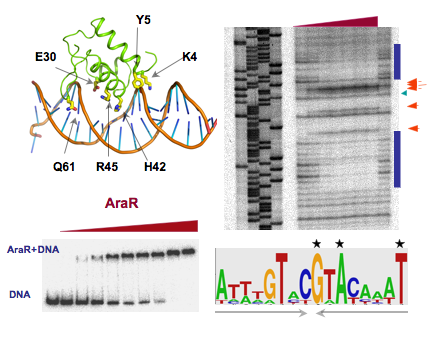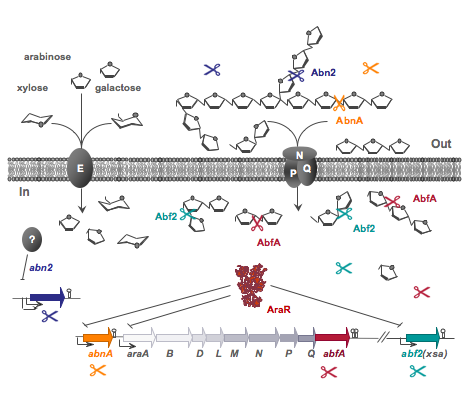Microbial Genetics Lab
 | Research Interests |
|---|---|
Life at the cellular level must detect and respond correctly to diverse internal and external stimuli. The transcriptional regulatory system ensures the correct expression of specific genes at suitable times and plays a central role in controlling various biological processes: cell cycle, maintenance of intracellular metabolic and physiological balance, and cellular differentiation. Modifications in the regulatory system, such as different regulatory activity and specificity of transcription factors, are main fonts for evolutionary adaptation and diversity. On the other hand, a considerable number of diseases are consequence of a malfunctioning regulatory system. Currently we are carrying out two major research projects: the first focuses on mechanisms of gene regulation that involve the AraR transcription factor, the second project addresses the characterization of a hemicellulolytic system.
AraR-DNA key contacts. Structure of the modelled N-terminal domain of AraR highlighting the residues in which site-directed mutations lead to a constitutive phenotype (top left). Consensus 16-bp palindromic operator sequence inferred from eight AraR boxes (bottom right). Stars point out the most critical bases for AraR-DNA contacts (adapted from Franco et al., 2007). AraR-DNA interactions analyzed by Dnase I footprinting (top right) and EMSA (bottom left).
| |
Hemicellulases are enzymes that are important both for the global carbon cycle and for biotechnological applications, such the conversion of hemicellulose to fuels and chemicals. In addition to the design of efficient enzymatic systems for economic degradation of the plant cell wall, the remaining challenges in the field of hemicellulases include the elucidation of the regulatory mechanisms and the creation of novel enzyme functionalities. We are addressing these questions through the genetic and biochemical characterization of an enzymatic consortium involved in the degradation of plant cell wall arabinose-containing polysaccharides, either in the soil or as part of the digestive tract of animals. The identification of genes, signals, and proteins involved in this regulatory network, which includes the intervention of the carbon catabolite repression mechanism, is the ultimate goal of this project.
Model for the degradation of arabinan by Bacillus subtilis. The homopolysaccharide is degraded by two major extracellular endo-arabinanases (GH43), AbnA and Abn2. The resulting products, arabinose, and arabino-oligosaccharides, are transported by different systems AraE and AraNPQ. These latter products are further digested by the concerted action of two GH 51 intracellular arabinofuranosidases, AbfA and Abf2 (adapted from Inácio & Sá-Nogueira, 2008).
|





